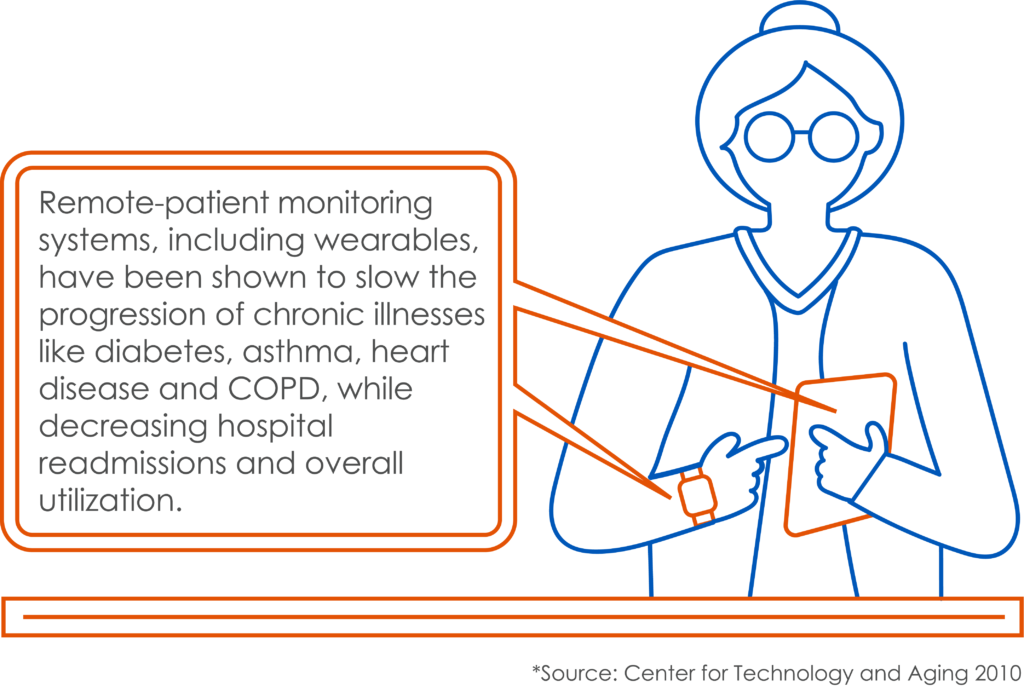In 1972, when gerontologist Andrew Dibner introduced the Lifeline — the first personal emergency alarm activated by a button, and today branded as the Philips Lifeline — seniors became among the first adopters of modern wearable technology.
Today, wearable devices — from activity trackers to heart rate monitors, sleep trackers and glucose monitors — are ubiquitous. But unlike the Lifeline, today’s wearables are often geared mostly toward a younger, tech-savvier generation. But what about seniors?
Seniors can significantly benefit from wearable technology
Seniors stand to benefit substantially from wearables technology, especially for in-home care. Seniors, as a group, account for over half of U.S. healthcare spending, and 77% live with at least two chronic conditions. Any cost-effective, portable, easy-to-use technology that could encourage seniors to stay healthy, manage their chronic illnesses, or help predict or prevent degradations in their health would prove a significant boon to senior care. Providers have shown significant interest in the space, and major manufacturers — from Apple, to Samsung and Philips — have begun to flood the market with senior-friendly products.

Research suggests that many wearables could prove medically beneficial. For instance, activity trackers have been shown to encourage physical activity among seniors, especially those who have never before tried the technology. Such devices have been demonstrated to improve medication adherence among patients with multiple chronic conditions. Other technologies, like remote-patient monitoring (RPM) systems, which includes wearables, have been shown to help slow the progression of chronic illnesses like diabetes, asthma, heart disease and chronic obstructive pulmonary disease, while decreasing hospital readmissions and overall utilization.
Dr. Jennifer Terrell, Executive Medical Director at naviHealth, has witnessed the significant impact of medical innovation to the healthcare community and patients first-hand with over 20 years of experience.
“More and more clinically relevant technology and innovation is created every day,” said Dr. Terrell. “Over the course of my medical career, I’ve seen medical innovation evolve significantly. Take how we calculate a patient’s international normalized ratio (INR), which is a blood test used to properly dose blood thinners. This used to be a study that you had to send off to a lab and we would get the results in two to three days. Then, we brought the test in-house into the clinic. Now, it’s something you can do from your home allowing the medication dosage to be managed telephonically.”
As the adoption of wearables grows, there are now more opportunities than ever for reimbursement. Beginning in 2020, the Centers for Medicare & Medicaid Services (CMS) fee schedule will include the opportunity for reimbursement for RPM technology and mHealth services. Private Medicare Advantage (MA) insurers have shown increased interest in covering wearables, such as with the news that one insurer would subsidize the cost of Apple Watches, with their ECG, atrial fibrillation detection and fall detection features. Moreover, as of 2020, MA plans will be able to bill for services that have a “reasonable expectation of improving or maintaining the health or overall function of the enrollees,” which likely includes wearables.

Executive Medical Director
naviHealth
“I see wearable technology as a catalyst for Medicare Advantage plans and the overall strategy of keeping patients at home and out of the hospital. But it’s a large financial responsibility to buy these devices on your own as a senior, especially if you don’t know if they will work for you,” explains Dr. Terrell.
Meanwhile, technologies like fall detection sensors have reportedly shown significant improvements to their performance and usability. What’s more, separate research has shown the ability of fall detection software to predict falls among aging women, allowing providers to intervene ahead of time. Falls are a particular hazard for seniors: they are the leading cause of both fatal and non-fatal injuries, and each year, result in three million emergency room visits, for a combined cost of roughly $50 billion.
The question remains about adaptation and if seniors would be accepting of this new technology that they may not be familiar with. A study showed 80% of patients over the age of 55 believe that technology will help improve health care over the next half-decade, and monitoring technologies like wearables are at the top of their wish lists.
“The Boomer generation is much savvier and more open to using new technology than the younger generation assumes, they just want something practical, simple and that fits in their lifestyle,” Dr. Terrell said. “Don’t forget – they were middle age when there was a technology explosion. This is the same generation that went from typewriters, to word processors, to sending emails on their personal computers – they’ll be fine. Technology doesn’t scare them – all they want is good technology. If we can find that sweet spot of adaptability and simplicity, seniors will likely take a new technology and run with it beyond anyone’s expectations.”
Playing the devil’s advocate
Despite the current hype about wearables, there are a number of potential obstacles to their adoption. The largest hurdle, perhaps, is the fact is that the market is currently saturated with consumer devices, the vast majority of which have not been rigorously studied, nor cleared by the U.S. Food and Drug Administration (FDA) for medical use. In general, consumer wearables are not required to be regulated if they’re intended merely promote general wellness — which, as the AMA notes, includes encouraging an overall state of health and activity, or reducing the likelihood or impact of chronic illness.
“Technology can produce incredibly relevant and valid patient data. We need to conduct the right studies to understand what keeps people out of hospital, what information best triggers a visit from a home health agency or a provider in a home-based primary care setting,” according to Dr. Terrell. “If the technology can pinpoint what specific biometrics we should identify using patient driven data and how we can get the data from the patient to the physician in the simplest way possible, then, we can reduce initial admissions to hospitals in addition to reducing readmissions.”
Even where wearable technologies have been well-studied, such as with fall detection devices, there are often research shortfalls. For instance, a scoping review of fall detection research found that laboratory studies rarely reflect how those devices are used among seniors in real-world settings — few research participants, the review found, are seniors at all.
The FDA is working to speed up clearances for specific low-risk devices through its new Precertification (Pre–Cert) Program, which is expected to go live sometime after 2019. Meanwhile, the FDA is increasingly fast-tracking clearances for other low-risk devices, including the Apple Watch heart monitoring features, through its premarket approval, De Novo, and Breakthrough Program application processes.
Still, such devices, ranked as FDA Class I or II, do not require clinical trials to demonstrate their safety and effectiveness. Providers will need to pay close attention to these regulations as they rapidly evolve, as well as clinical assessments that support, or refute, the clinical viability of select wearables for senior care.
Then, there are the more familiar, if not stereotypical, obstacles. Despite seniors’ enthusiasm for wearables, they still use digital health devices at far lower rates than other segments of the population. Seniors, in general, tend to take less readily to new technologies: only 25% say they feel confident using computers, and nearly half say they need help using electronic devices.
“The younger generation may purchase two or three pieces of new technology, and if they don’t like it, they can sell the item online. The senior population isn’t necessarily going to go this route,” Dr. Terrell said. “Bringing them something vetted, with the possibility of reducing the financial obligation, will lower the barrier and will allow for more seniors the opportunity to utilize the new technology.”
Adding to this, the development of certain chronic conditions can make adoption particular difficult. One study found that seniors who have new dementia, have relocated to a nursing home, or who have declining physical performance, may be particularly poor candidates for technology interventions.
Wearables also must be designed to account for declining functions among seniors, such as in vision, hearing, cognition, memory, mobility, motivation and grip strength. Yet, usability studies have shown that wearables commonly fail to meet these needs. Cost, likewise, remains an issue, if devices cannot be covered: only 26% of seniors say they are willing to pay out-of-pocket for wearables.
The upshot is that as more devices become available to providers, and more research guides the use and implementation of wearables in real-world settings, providers will have more options at their disposal to improve senior care. As in the early 1970s, emerging wearable technologies may very well become a mainstay in efforts to improve the lives of the senior population.
Click here to read some of the biggest concerns facing seniors in 2020.



